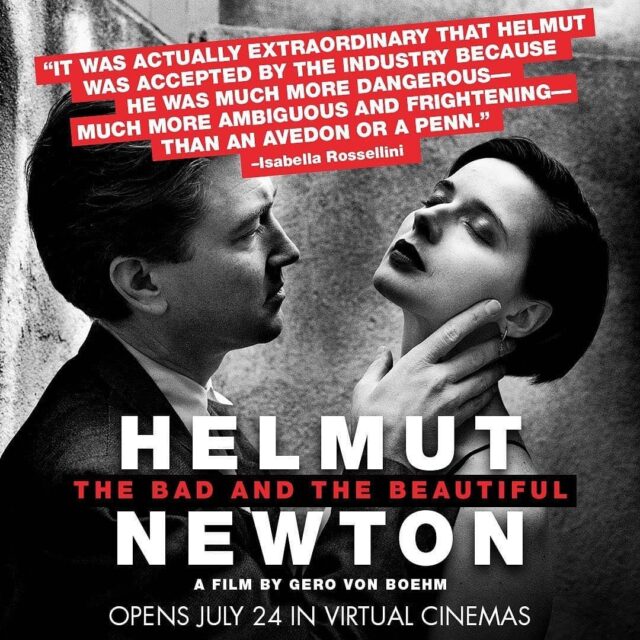Trailblazing German-Australian fashion photographer, Helmut Newton, is a polarising figure who claimed to be a feminist despite critics labelling his nude portraits as unquestionably misogynist.

Now a documentary feature film, Helmut Newton: The Bad and the Beautiful, set to screen at the now postponed Melbourne International Film Festival (MIFF), has asked some models working with Newton to set the record straight.
Newton is famous for his provocative portraits showing fully or partially naked models in an often sexualised way. Even a 1994 French Vogue photo of a model’s hands tearing apart a roast chicken is, as noted by The Australian‘s reviews writer Rosemary Neill, ‘strangely sexualised’.
Newton admitted he loves vulgarity and is ‘very attracted to bad taste’, characteristics that earned him the title ‘king of kink’.
Newton died in 2004, bringing his five decade-long career to an end. But if he somehow managed to live much longer than an ordinary lifetime and continued working and behaving in his same risky manner, it’s hard to imagine he’d have many jobs on the schedule. By today’s standards, his work would likely create more outrage than before, and it would be a question of how and when, not if, he’d be called out and cancelled.
Director Gero von Boehm had political correctness and cancel culture in mind when making the film. He told The Australian that an objective was to show ‘how important a certain amount of provocation is in photography, in the arts’.
‘I would be happy if the documentary encourages young photographers and artists to go to the limits, to have the courage to be a little more anarchistic and not be politically correct all the time,’ he said.
The director’s personal opinion is that cancel culture is ‘terrible. We need freedom of art. We need freedom of expression’. He believes Newton wasn’t a sexist and ‘on the contrary, in many of his pictures he wanted to show us how strong women are’.
However his biopic provides the women who worked with Newton ‘carte blanche’ to let it all out. The film hears from Newton’s recently-deceased wife, June Newton, legendary Vogue editor Anna Wintour, and portrait subjects Grace Jones ,Isabella Rossellini, Charlotte Rampling, Claudia Schiffer, and Marianne Faithfull.
So what did they have to say? A quick spoiler alert.
According to a review in RogerEbert.com, with reviewer Roxana Hadadi giving it two and a half stars, the film ‘doesn’t make space for any viewpoints other than complimentary ones’. The only moment where Newton is criticised is during an old TV interview, where the late feminist, Susan Sontag, tells Newton his images are ‘very misogynous’.
Newton replies: ‘I love women. There is nothing I love more,’ to which Sontag responds: ‘The master adores his slave. The executioner loves his victim.’
While Hadadi praises the film for giving the voiceless women from Newton’s photos an opportunity to speak, the reviewer feels there was minimal effort to uncover someone with an opinion similar to Sontag, or even ‘mildly critical’. She wrongly suggests model, Cindy Crawford, may have some revealing opinions about how Newton treated her, with her seen shivering in a swimming pool while having orders barked at her. Months ago Crawford said in a video for Vogue that ‘I loved working with Helmut. I mean, Helmut had a style and you kind-of knew what you were signing up for’, so it seems she isn’t the one to tarnish his reputation.
Italian-American actor, Rossellini, a feminist who starred in David Lynch’s cult classic Blue Velvet, argues there is a complexity to Newton’s images that expose western society’s ‘machismo’. How men’s attraction to women makes them feel weak and threatened.
Reviewer, Owen Gleiberman, writing for Variety, sums up how Newton’s work has an ‘ambivalence – a fantastic double vision’. While his ‘centerfold-from-hell vision are ‘rooted in male fantasy’, they also display the ‘awesomeness of feminine power’. Gleiberman writes:
‘Yet even as Sontag condemned his work, you could make a case that in teasing out the culture’s darker undercurrents, Newton created images that were progressive in their very danger. He revealed the lower depths of what was out there. Charlotte Rampling, who collaborated with him on a stunning series of hotel-room shots in 1973, says, “It’s great to be a provocateur. It’s what the world needs — because it stimulates thoughts, it stimulates ideas, and it stimulates all sorts of conversations.” Anna Wintour, who gave Newton a platform at Vogue, defends him as someone who bracingly undercut the rules of beauty.
– Helmut Newton: The Bad and the Beautiful is set to screen at MIFF, and will show in cinemas later this year.





I generally find that artistic interpretations by commentators on a deceased artist’s work generally say more about the commentator than the artist no longer able to defend them self.